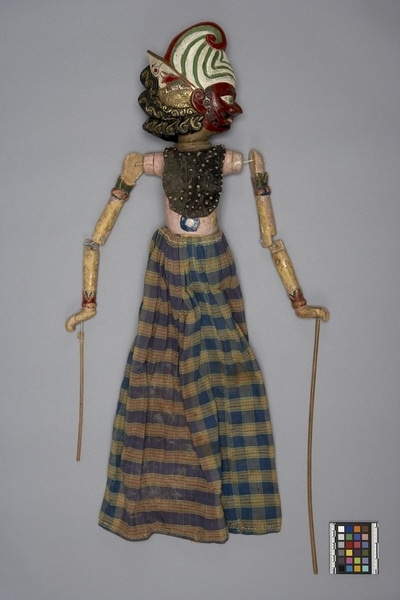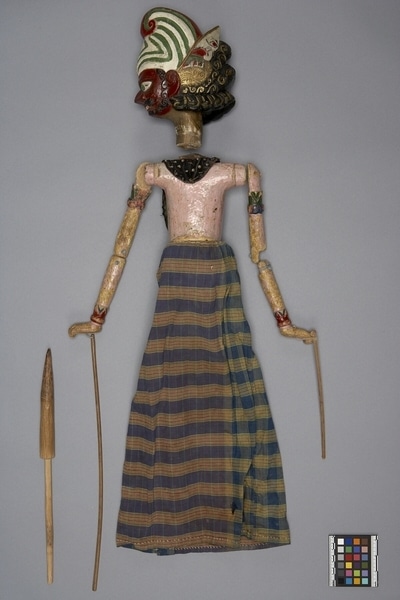Rod Puppet Item Number: Ib336 a-c from the MOA: University of British Columbia


Description
Three-dimensional male humanoid puppet: large head (part b) fits into body with skirt (part a), and a control rod (part c) with a long shaft that passes through the body and fits into the neck of the figure's head. The body has jointed arms, each with a long controlling rod attached. Red face, bulging eyes with green irises, black moustache, beard and sideburns, blunt protruding nose, white and gold upper teeth slightly protruding. Green and white striped turban, gold sumping, white Garuda Mungkur with short red tongue. Black curly hair decorated with gold appearing from back of headdress. Gold neck. Head detachable and joined to body by controlling rod. Pink rounded torso; swelling breasts; blue circles around breasts and navel. Breasts covered by black velvet yoke with appliqued seed beads; velvet worn and some beads missing. Yoke attached to chest and back with nails. Pink arms articulated at shoulder and elbow by string. Green and blue upper arm, and blue and red wrist ornaments. Hands at right angles to arms with fingers curled; attached by string to controlling wands. Blue, green, orange and yellow plaid skirt.
History Of Use
Javanese puppetry as an art form probably developed by the 11th century. The three-dimensional wooden wayang golek puppets of western Java appeared during the 16th century. Originally the plays depicted Javanese mythology, but after the Indian conquest of Java the Hindu epics, Ramayana and Mahabharata, were incorporated into the cycles, which comprise about 200 plays. An individual or group hires a dalang (puppet-master) to celebrate important occasions. The performances often last all night and are generally presented in three acts, with vocal and instrumental accompaniment. The individual plays vary widely in detail but usually involve conflict between good and evil. They serve a moral and religious purpose, and more recently, one of political commentary. Each puppet's character is represented by its appearance and placement onstage; protagonists with strong elements of good are placed to the right, antagonists of violent or evil nature to the left. The ogress, Sarpakanka, is found in the Ramayana epic, in which the exiled Prince Rama and his half-brother Lakshmana meet the ogress in the forest. She attempts to seduce Lakshmana who cuts off her ear in disgust. Rama later allies himself with Sagriwa, the king of the white monkeys, whose general, Hanuman, kills Sarpakanka.
Cultural Context
Theatrical performance.
Iconographic Meaning
Red face, protruding eyes and blunt nose, rounded torso and covered breasts are all characteristics of the hermaphroditic ogress, Sarpakanka. The red face indicates violent nature, and protruding eyes and nose are coarse traits and generally considered evil. Significance of green eyes is unclear; however, the trait is certainly very negative.
Item History
- Made in Java, Indonesia
- Owned by Tradewind Antiques before March 15, 1983
- Received from Museum of Anthropology Shop Volunteers (Funding source) and Tradewind Antiques (Seller) on March 15, 1983
What
- Name
- Rod Puppet
- Identification Number
- Ib336 a-c
- Type of Item
- puppet
- Material
- wood, cotton fibre, paint, glass and metal
- Manufacturing Technique
- carved, painted, machine woven, stitched and nailed
- Part A
- height 71.5 cm, width 22.0 cm, depth 9.5 cm
- Part B
- height 21.5 cm, width 10.5 cm, depth 16.7 cm
- Part C
- height 38.5 cm, width 2.5 cm, depth 2.0 cm
Who
- Culture
- Sundanese
- Previous Owner
- Tradewind Antiques
- Received from
- Museum of Anthropology Shop Volunteers (Funding source) and Tradewind Antiques (Seller)
Where
- Holding Institution
- MOA: University of British Columbia
- Made in
- Java, Indonesia
When
- Ownership Date
- before March 15, 1983
- Acquisition Date
- on March 15, 1983
Other
- Condition
- fair
- Accession Number
- 0886/0070 a-c